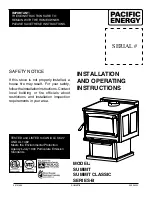
6
Operating Instructions and Owner’s Manual
Grand Teton Wood Pellet Fire Stove
CLEARANCE TO COMBUSTIBLES
The following stated clearances represent the
minimum distances between the stove and any other
object. No objects should encroach into this space.
This includes but is not limited to carpet, furniture,
children, pets, clothing, fuel, or any other object. These
clearances may only be reduced by means approved by
the regulatory authority having jurisdiction.
A
D
D
D
C
B
E
REAR WALL
SIDE WALL
FRONT OF HEATER
‘B’ - VENT THROUGH
REAR WALL
‘E’ - VENT WITH
VERTICAL VENT
PIPE
NON-COMBUSTIBLE
FLOOR PROTECTION
Figure 1
Clearance to Combustibles
USA
CANADA
A
13” (330 mm)
13” (330 mm)
B
2” (51 mm)
2” (51 mm)
C
18” (457 mm)
18” (457 mm)
D
8” (203 mm)
8” (203 mm)
E
3” (76 mm)
3” (76 mm)
FLOORING SPACE & CLEARANCES
When installed on a combustible floor, non-
combustible floor protection is required to:
•
Cover the area beneath the stove and extend at
least 18 inches (457 mm) to the front
•
Cover the area at least 8 inches (203 mm) beyond
each side of the room heater.
•
Cover the area under the exhaust venting and 2
inches (50.8 mm) beyond each side.
Additionally, the wood pellet fire stove shall be
positioned such that:
• It has at least 13” (330 mm) of clearance from the
each side to the nearest body.
• It has at least 2” (51 mm) of clearance from the
rear to the nearest body.
• Vertical runs of vent pipe must be at least 3” (76
mm) from any wall.
Finally, the area which the wood pellet fire stove is
installed shall have a floor-to-ceiling distance of at least
84” (2134 mm).
FLOORING MATERIAL
Floor protection must be all of the following:
•
Listed to UL 1618.
• At least 0.5” (13 mm) thick
•
Constructed of non-combustible material.
•
Have either:
Thermal resistance value R of 1.19
(ft
2
)(hr)(
0
F)
Btu
Thermal conductivity value k of 0.84
(Btu) (inch)
(ft
2
)(hr)(
0
F)
For assistance evaluating the suitability of substitute
materials, the following equivalences of specifications
and example below have been provided.
Thermal conductivity k =
thickness
R
(
(Btu) (inch)
(ft
2
)(hr)(
0
F)
or
W
(m)(
0
K)
)
Thermal conductance C =
1
R
(
(Btu)
(ft
2
)(hr)(
0
F)
or
W
(m
2
)(
0
K)
)
Example: Required to protect floor with R value of 1.19
(ft
2
)(hr)(
0
F)
Btu
.
Evaluating merit of 2¼ inch (57 mm) thick brick with
thermal conductivity k = 4.16
(Btu) (inch)
(ft
2
)(hr)(
0
F)
on top of ¼
inch (6.3 mm) thick mineral board that has C value of
2.3
(Btu)
(ft
2
)(hr)(
0
F)
.
Step 1. Calculate the R value of each floor material
R
BRICK
=
thickness
k
=
2.25
4.16
= 0.54
R
BOARD
=
1
C
=
1
2.3
= 0.434
Step 2. Add the equivalent R values for each floor
material
R
BRICK
+ R
BOARD
= 0.54 + 0.434 = 0.974
Step 3. This combined R value is
insufficient
and
so more protection must be provided. For
example, by using 2 layers of bricks:
R
BRICK
+ R
BRICK
+ R
BOARD
= 0.54 +0.54 + 0.434 = 1.514
Step 4. Because this combined R value is larger than
the specification, this is a sufficient method for
protecting the floor area underneath the stove.
(Imperial or SI units)







































